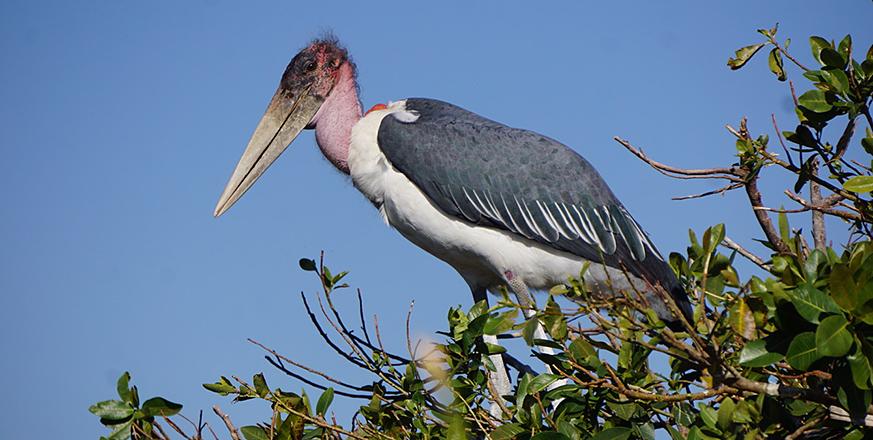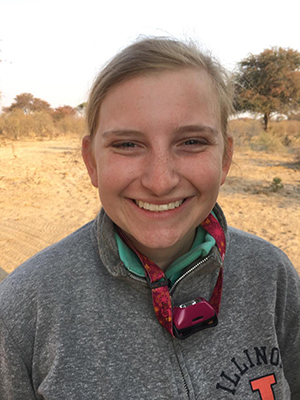Notes from the Field: Juliette Nye - Into the Heart of the Delta

The morning was eventful, starting with a mini-game drive before we departed Moremi Game Reserve. One of the first things we saw was a Great White Pelican, standing alone in shallow water. Mothusi, our guide, told us that pelicans are really fascinating birds because they are able to catch a fish and subsequently squeeze the water out of their mouth, all without letting go of the fish! Lucas, one of the graduate students on our trip who knows a lot about birds, shared that because pelicans are so heavy, formation during migration is extremely important. High pressure from underneath the wing and low pressure from above the wing create a vortex, which allows for the birds in the formation behind the front bird to stay in flight without high exertion.
We next saw a hippo pathway, easy to distinguish from an elephant pathway, as the hippo paths have a median while elephant paths are a single trail. It is from these hippo walkways that new waterways are later formed once the Okavango Delta floods. We also observed many adult giraffes and 3 juveniles, 1 of which still had its umbilical cord attached, meaning that it is less than 2 weeks old. While all this sounds amazing (which it was), the most unusual thing that we saw that morning was a serval cat! Servals are quite rare to see, especially in Moremi Game Reserve; this one was in plain sight sitting on a log! These cats have white spots on the backs of their ears, which is used as a "follow me" signal to other servals. This sighting was the perfect subject for an afternoon sketching session.

Following a tea/coffee break out in the bush and a delicious lunch, we loaded onto two small boats to travel up the river to the island we were staying at that night, Gadikwe Island. The driver of the boat I was on was named Fly, and let me tell you, he really flew across the water! On the way, we were lucky enough to see two pairs of clawless otters, which are also extremely rare to see in the Delta. Even though there are many of them living in the Okavango Delta, the water system is so large and has so many great spaces to hide that an otter sighting is unlikely. Gareth and the boat captains then navigated us to a rookery where many of the birds in the Delta like to make their nests. Among the nesting birds were a bunch of Maribou Storks, which are a little silly-looking with their huge bodies, bald heads, and a red air sac on their neck, but they are really incredible creatures. Several were bunched together, sitting on top of nests. Maribou Storks nest very high up in trees, as they are at the top of the animal "hierarchy," and otherwise, their large wings would disturb other birds' nests. Their legs are black, but typically turn white after they urinate and defecate on them as a form of sunscreen and to help keep cool.
Then, perhaps the coolest sight of the day: we saw a young bull elephant porpoising, swimming across a channel of the Delta from island to island! He would alternate with putting his head above water, then his trunk above water to suck in air. It was the most amazing experience to see this in real life: to see a gentle giant swimming! Elephants are apparently really good swimmers, and are able to dog-paddle their way through water. Everyone was just blown away by this incredible sighting: if we were even 5 minutes earlier or 5 minutes later, we would have missed it.
Gareth taught us that many animals that live in the Delta, even big cats (who we would assume don't like water), have adapted to living in the environment by swimming across channels. From an animal-behavior perspective, I loved learning about how these animals, no matter the species, are so well-adapted to living in the Delta. The Okavango Delta is already such a unique ecosystem solely in its sheer numbers of mammal, reptile, bird, and plant species, that this was just the cherry on top.
In the evening, Dr. Tony Barnosky, an expert in paleontology and the executive director of Jasper Ridge Biological Preserve, gave us an interesting insight into the current extinction crisis and possible Sixth Mass Extinction that we are currently facing. Over the last 40 years, humans have been responsible for killing about 50% of the world's wildlife. While this is a depressing statistic, the good news is that it is still possible to save this planet and our planet's wildlife. As humans, we all need to work together to create a more eco-friendly way of living to improve and protect our environment. This was a really eye-opening discussion that taught me a lot more about how extinction history is still being made today, and that we all need to do our part to conserve wildlife and the entire planet.
 Juliette Nye is an incoming senior pursuing a dual-degree in Animal Sciences and French Studies at the University of Illinois at Urbana-Champaign
Juliette Nye is an incoming senior pursuing a dual-degree in Animal Sciences and French Studies at the University of Illinois at Urbana-Champaign



